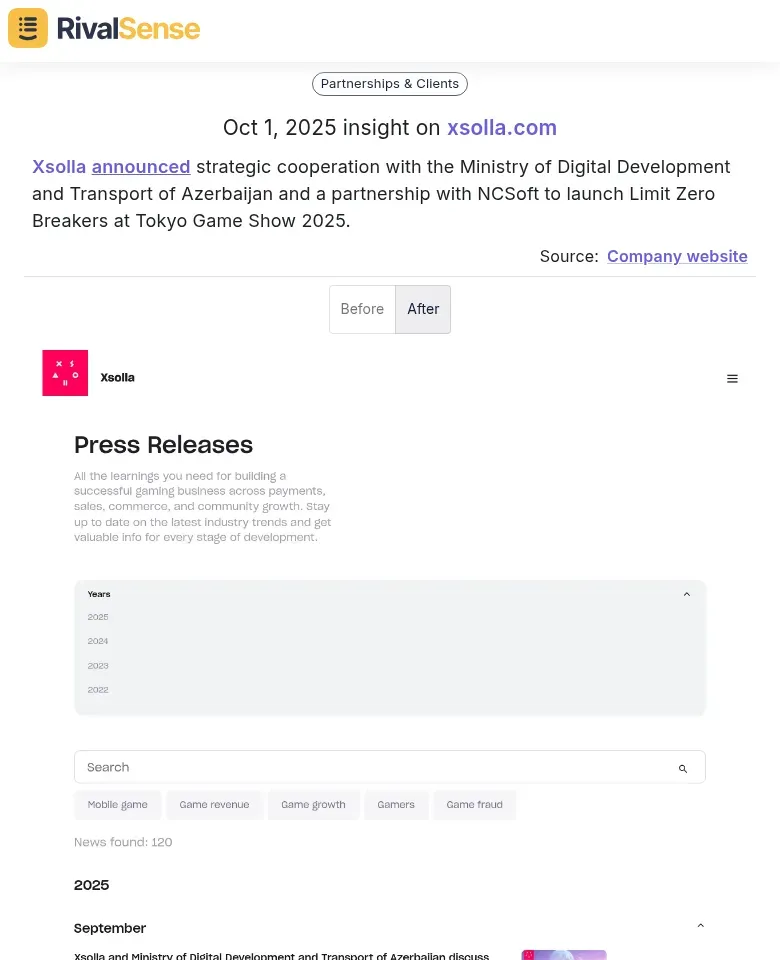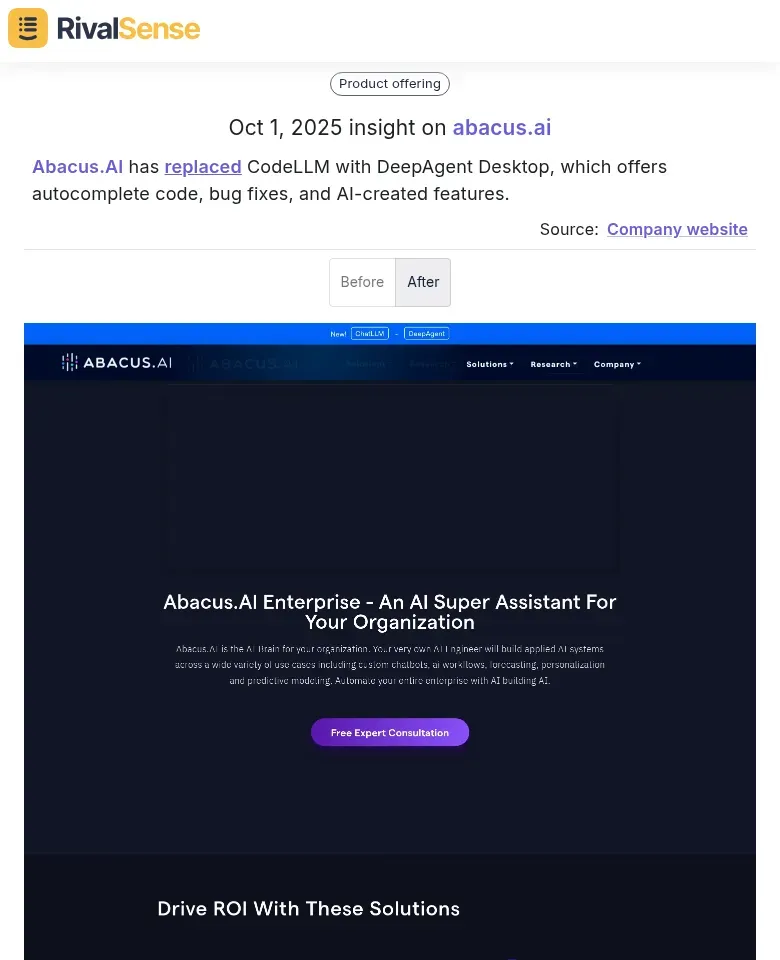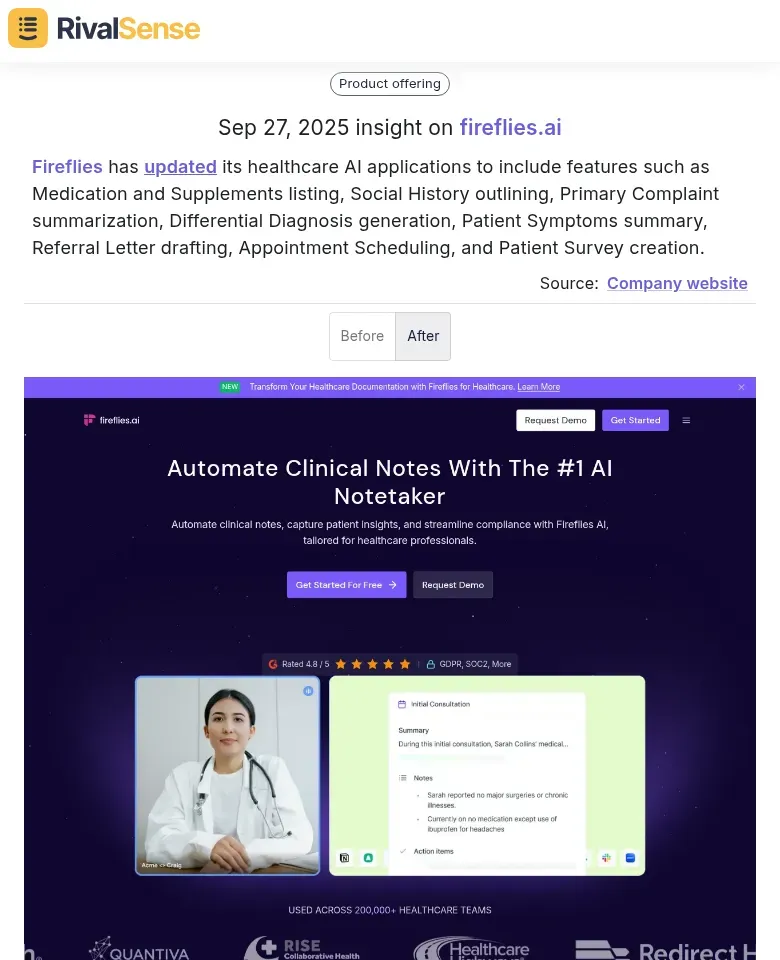Real-World Examples: How Competitor Website Changes Drive Key Account Wins
In today's competitive landscape, your competitors' websites are dynamic intelligence hubs that reveal strategic shifts before they're formally announced. When a B2B company redesigns its pricing page, adds new case studies, or launches a product feature, these aren't just cosmetic updates—they're signals of market repositioning, target audience changes, or new value propositions. For business leaders, monitoring these changes provides actionable intelligence that can directly impact key account acquisition. For instance, when a competitor quietly removes enterprise-tier pricing, it may signal a shift toward mid-market focus, creating immediate opportunities to capture their former enterprise clients.
The competitive advantage lies in proactive monitoring: set up alerts for competitor homepage changes, track new customer logos in case studies, and analyze feature announcement timing. Practical steps include creating a weekly competitor website audit checklist, using tools that capture historical snapshots, and establishing a cross-functional review process where sales, marketing, and product teams discuss competitor movements. By transforming website monitoring from passive observation to strategic intelligence, you can anticipate market moves, position your offerings more effectively, and turn competitor changes into your key account wins.
Strategic Partnership Announcements: Decoding Expansion Signals
When competitors announce partnerships, they're revealing expansion blueprints that can reshape market dynamics. Tracking these announcements helps you identify new market entry strategies and timing opportunities before they fully materialize. For example, RivalSense recently captured that Xsolla announced strategic cooperation with the Ministry of Digital Development and Transport of Azerbaijan and a partnership with NCSoft to launch Limit Zero Breakers at Tokyo Game Show 2025. This type of insight is valuable because it uncovers geographic and technological expansions, allowing you to anticipate competitive moves and adjust your market positioning or partner outreach accordingly.

Identifying Market Expansion: 📈
- Monitor partnership types: geographic (new regions), vertical (new industries), or technological (new capabilities)
- Example: A SaaS company partnering with regional distributors signals international expansion
- Tip: Use automated tracking tools to catch announcements within hours
Analyzing Diversification Strategies: 🔍
- Map partnerships against market gaps: Are they targeting underserved segments?
- Assess geographic patterns: Multiple partnerships in one region indicate focused expansion
- Checklist: Document partner profiles, target markets, and stated objectives
Timing Counter-Strategies: ⏰
- Act within 30-60 days of competitor announcements—this is the implementation window
- Pre-empt expansion by strengthening relationships with their target partners
- Practical step: Create a "partnership response playbook" with pre-approved countermeasures
Key Insight: 83% of expansion opportunities are visible in partnership announcements 3-6 months before full market entry. Use this lead time to fortify your position.
Product Feature Updates: Spotting Innovation and Market Gaps
Product feature updates reveal critical market intelligence about evolving customer needs and competitive positioning. When competitors replace or enhance features, they're often addressing pain points or capitalizing on emerging trends that you might have overlooked. For instance, RivalSense tracked that Abacus.AI has replaced CodeLLM with DeepAgent Desktop, which offers autocomplete code, bug fixes, and AI-created features. This insight is valuable because it highlights innovation shifts and potential market gaps, enabling you to benchmark your product roadmap and identify areas for differentiation or improvement.

Track these changes systematically: monitor competitor release notes, analyze their help documentation updates, and watch for feature announcements. Create a simple spreadsheet tracking feature additions, removals, and modifications monthly. This reveals underserved customer needs—if multiple competitors add integration capabilities, there's likely unmet demand for ecosystem connectivity.
Benchmark your roadmap against these insights. Ask: Are we addressing the same customer problems? Where are we ahead or behind? Practical tip: Set up Google Alerts for competitor names + "new feature" or "product update" to catch announcements early. Use this intelligence to validate your own feature priorities and identify gaps in your offering that could become competitive advantages.
Industry-Specific Enhancements: Targeting Niche Markets
Recognizing vertical specialization through feature additions is key to capturing underserved markets and driving growth. When competitors tailor their offerings to specific industries, they signal opportunities for you to either compete head-on or find adjacent niches. For example, RivalSense observed that Fireflies has updated its healthcare AI applications to include features such as Medication and Supplements listing, Social History outlining, Primary Complaint summarization, Differential Diagnosis generation, Patient Symptoms summary, Referral Letter drafting, Appointment Scheduling, and Patient Survey creation. This type of insight is valuable because it reveals focus on high-value verticals, helping you identify where to allocate resources or develop specialized solutions.

Analyze workflow integration opportunities by mapping industry-specific processes—like a CRM tool integrating with construction project management software to capture that underserved vertical. Identify underserved verticals by tracking competitor website changes; if they ignore a niche, it's your opportunity.
Practical Steps: 🛠️
- Monitor competitor feature releases for industry-specific patterns
- Map workflows in target verticals to spot integration gaps
- Use tools like RivalSense to track website updates revealing market shifts
- Conduct customer interviews in overlooked niches to validate needs
- Pilot minimal viable products (MVPs) tailored to these verticals before full launch
Tip: Start with one vertical, dominate it, then expand. This focused approach builds credibility and drives key account wins efficiently.
Actionable Intelligence: Turning Insights into Account Wins
When competitors update their websites, they reveal strategic gaps and weaknesses that you can exploit to win key accounts. By monitoring these changes in real-time, you can identify customer pain points they're no longer addressing and position your solutions as superior alternatives. For example, if a competitor drops support for a specific integration, develop targeted messaging highlighting your seamless solution.
Timing is critical: launch outreach campaigns during competitor transition periods when customers experience disruption. Use automated alerts to monitor real-time changes and alert your sales team immediately.
Build Competitive Differentiation Checklist: ✅
- Identify 3 key competitor weaknesses from their recent website updates
- Create tailored messaging that addresses these gaps
- Time outreach to coincide with competitor announcements or migrations
- Prepare case studies showing how you solve the problems they've created
- Train sales teams on specific talking points that highlight your advantages
Practical tip: Set up automated alerts for competitor homepage changes, pricing pages, and feature announcements to stay ahead of market shifts.
Implementation Framework: Building Your Monitoring System
Building an effective competitor monitoring system requires a structured approach that integrates seamlessly into your business operations. Start by establishing systematic website change tracking using automated tools to monitor competitor homepage layouts, pricing pages, case studies, and blog content. Set up alerts for specific triggers like new product launches, pricing changes, or leadership announcements to ensure you never miss a critical update.
Create a centralized dashboard where all team members can access real-time updates and collaborate on insights. Integrate these findings directly into your strategic planning by holding weekly review sessions to analyze competitor changes against your target accounts' pain points. For example, if a competitor adds enterprise security features, assess how this impacts your positioning for financial services clients.
Key Components of a Monitoring System:
| Component | Description | Example Action |
|---|---|---|
| Automated Tracking | Use tools to monitor website changes | Set up alerts for pricing page updates |
| Centralized Dashboard | Share insights across teams | Use a shared platform for real-time updates |
| Strategic Integration | Apply insights to account planning | Update battle cards with competitor weaknesses |
Measure ROI by tracking account acquisition metrics pre- and post-implementation. Calculate the win rate improvement for accounts where competitor intelligence informed your approach. Monitor time-to-close reductions and deal size increases attributed to competitive insights. Practical tip: Create a simple scoring system (1-5) for competitor threat level on key accounts, updating it monthly based on website changes observed.
Conclusion: Leverage Competitor Insights for Growth
By systematically monitoring competitor website changes, you can transform raw data into actionable strategies that drive key account wins. From partnership announcements to feature updates, each insight provides a window into your competitors' moves, allowing you to anticipate shifts and capitalize on opportunities. To streamline this process and gain a competitive edge, try RivalSense for free. Get your first competitor report today and start leveraging real-time insights to enhance your business strategy and outmaneuver the competition.
📚 Read more
👉 Optimize VPN Content Strategy with Competitor Performance Tracking
👉 Predictive Pricing Insights: Outsmart Competitors in Key Account Management
👉 How Stannah's Design-Driven Stairlift Launch Offers Key Competitor Insights
👉 How to Track Competitor Content Performance: A Step-by-Step Guide for B2B Leaders
👉 Cybersecurity Key Account Identification: 2025 Trend Analysis
